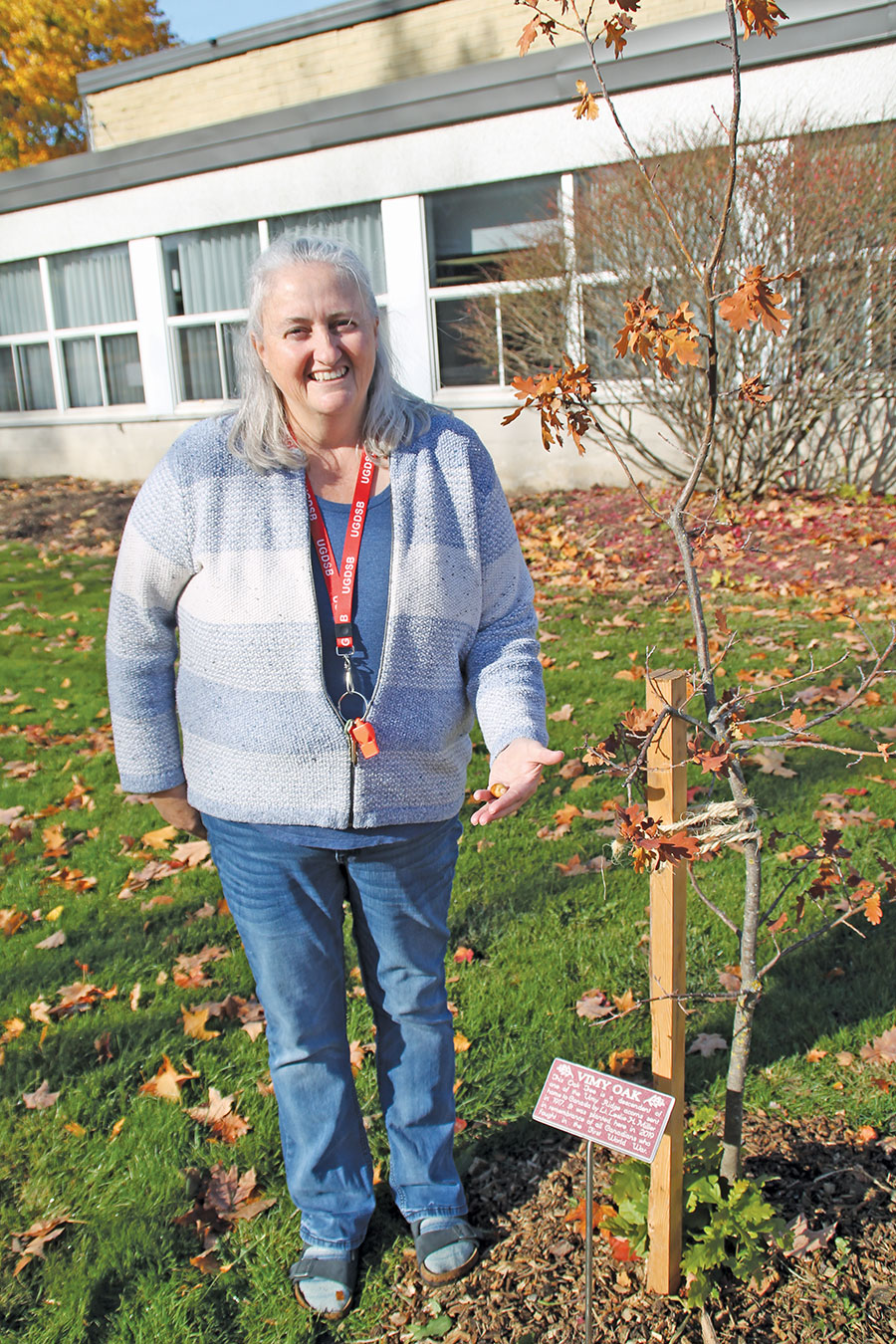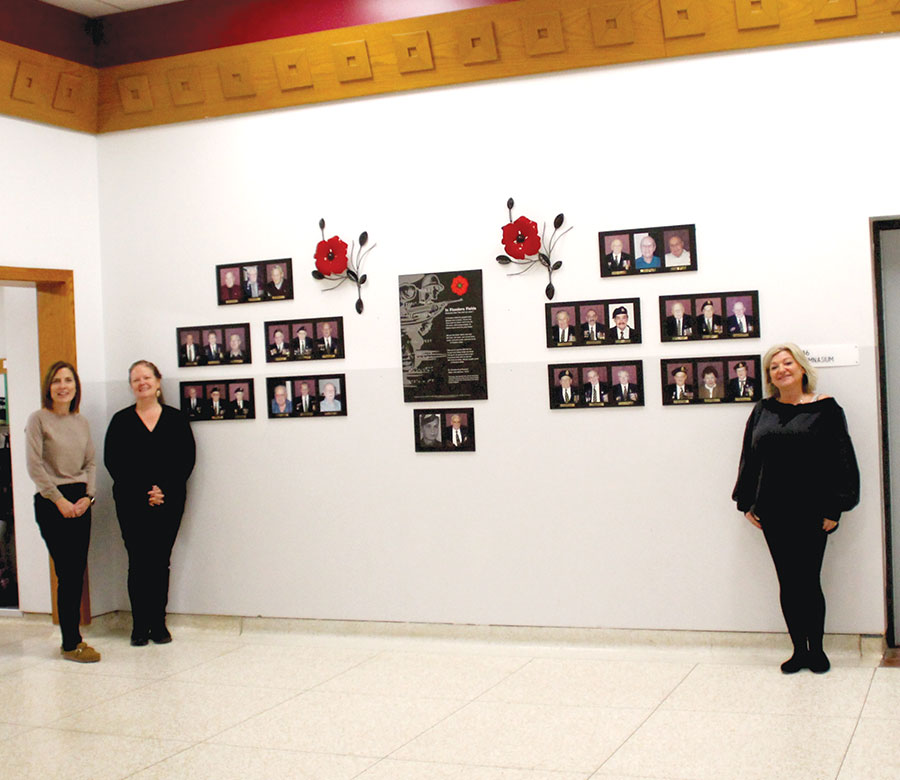MOUNT FOREST – Remembrance Day will be marked at schools across Wellington County.
For the students and staff at Victoria Cross Public School in Mount Forest, their school’s name is just one way they uphold their commitment to honouring local veterans in a way that ensures their legacy is not forgotten by future generations.
Kindergarten teachers Lisa Weber and Melody Elvidge credit a retired colleague for setting the bar high by incorporating the act of remembrance into lesson plans for approximately 20 years.
“Every single year, we have a Remembrance Day assembly and each year we change it up, but there’s the main things that stick and this stems back to a teacher named Donna McFarlane,” Weber said.
“She led us at the old building, and she continued to lead us here. So now that torch continues.”
Initially, McFarlane was responsible for dedicating each Remembrance Day ceremony to a living veteran in the community, inviting their family to join in to meet the students.
“The children would learn all about this veteran throughout the week, and they got to meet the veteran, and then we held a reception with this veteran and their families,” Weber said.
One of McFarlane’s lasting efforts was the creation of individual crosses that represented local veterans for the school’s annual Remembrance Day ceremony. The crosses are still used today.
“She made a cross for every soldier that did not come back to Mount Forest, that did not come home during World War One, World War Two and the Korean war,” Weber said.
“Each one represented former students and townspeople,” Elvidge added.
Weber explained that over 50 crosses were created, bearing the name of veterans on the roll call that is read at the Remembrance Day ceremony. Junior grade students are chosen to hold the crosses.
“As the roll call is read, they stand up with the cross representing one person that didn’t come back,” Weber said.
“When the roll call is finished and there’s the minute of silence, the students’ job is to look around, and whoever is reading the roll call will say to the students, “this represents the number of men and women that died at war from our community.”
It was an impactful moment the first time it was done decades ago, and Elvidge and Weber agree it’s just as impactful today.
New name, veteran stories
The pair say McFarlane was also instrumental, as part of a committee, in the renaming of the school in 2005, the year the Mount Forest Public School moved into the former high school building on Durham Street.
A decision was made to rename the school Victoria Cross Public School in recognition of two local veterans who posthumously received the Victoria Cross medal: Captain Frederick W. Campbell (June 1915) and Lieutenant Samuel Honey (September 1918).
It so happened that 2005 also marked “The Year of the Veteran,” so a group of the Victoria Cross teachers joined Mount Forest Legion Branch 134 members to conduct a special project, interviewing local veterans about their service experience and asking them to provide a message to students.
“They wanted to pass the torch to the people of Canada so that the memory of their sacrifices would continue and the values that they fought for would live on in all of us. They highlighted the promotion of peace,” notes a school history of the event.
“We interviewed them all and we provided a recording for all their families to listen to,” Weber said.
“For most of them, the families were so thankful because a lot of these veterans had not spoken of war since they had come home.”
Those stories not only benefited the veteran’s families, but helped when the school decided to dedicate a classroom to each of the living veterans.
“We decided it would be incredible if we dedicated a room to each living veteran, then as the children went through from kindergarten through to grade eight, they would come to know all the living veterans in our community,” Weber said.
“We had a picture of them when they were young, a wartime picture, with a little write up who they were as a human being, how many children and grandchildren they had, and everything else. And then we had their present-day picture.”
A mural of honour
The school created a veterans hallway, with pictures and artwork plus donated memorabilia, but over time, it felt dated and both Elvidge and Weber felt students and staff didn’t have the same personal connection to the stories.
It was time for something fresh and significant.
“The principal at the time, her name was Karen Sims, it was her idea to do a mural,” Weber said.
In 2017 artist Cliff Smith painted a large mural in the main foyer of the school, thanks to a donation from the Mount Forest Legion.
The images depicted include an homage to both men and women veterans from the Canadian Navy, Army and Air Force, as well as peacekeepers. Veterans are depicted passing their messages on to children, and students are seen reading about history.
The Vimy oak
In 2018, the school supported the Vimy Oaks Program when Somerville Nurseries donated 150 red oak trees that are descendants of acorns gathered after the Battle of Vimy Ridge and planted in Canada by Lieutenant Leslie Miller.
The program repatriated Vimy oak saplings to Vimy Ridge in 2018 and also distributed them across Canada.
Students at Victoria Cross Public School planted a tree next to the school’s Canadian flagpole, and then fundraised the sale of the remaining saplings to raise $1,000 for the program, which supports the maintenance of the memorial site.

Vimy Oak – Cathy Turner, a resource teacher at Victoria Cross Public School shows off the first oak nut bore by the Vimy oak tree in late October. Turner was instrumental in planting the tree at school in 2018.
Photo by Kelly Waterhouse
Each class read the book, The Vimy Oaks by Linda Granfield to understand the significance of Vimy Ridge and to understand the importance of the tree itself.
Vice principal Carol-Anne Sloan, who has been at the school for three years, said she is impressed by the spirit of her colleagues to continue to honour local veterans in special ways.
“Cathy Turner, one of our research teachers, spearheaded the planting of the Vimy oak tree,” Sloan said, expressing gratitude for the commitment of students, staff and the community to fundraise.
“We have a Vimy oak out front, and we have a plaque commemorating it.”
Two weeks prior to Remembrance Day, that oak tree bore its first oak nut, which caused some excitement amongst staff.
“Out of that Vimy oak, there this beautiful little ancestor to the original one. We’re kind of proud of that,” Sloan said.
School community
Planning their Remembrance Day events this year, staff talked of the challenges and concerns to make this year’s event relevant to students.
“We were reminiscing, of course, how it’s had to change because we lost our veterans, and that was firsthand information for the children, that these are real people that went and did this,” Weber said.
“And then our conversation is always where do we go from here? How do we make this relevant? How do we make this day not scary?”
Given the news of present day, Weber and her colleagues know that students are exposed to images of war.
“If we talk about relevance … you think about what’s happening in Ukraine, and how we do have some soldiers that are in a role in the Ukraine, as well as other places around the world,” said Sloan.
She noted it is important for her colleagues to make sure there is an understanding and acceptance of the need for inclusion around Remembrance Day.
“I’m talking about the impact of Indigenous Peoples, the Metis, the First Nations, and the Inuit had in the war. And I think it was one of those forgotten stories for many, many years,” Sloan said, noting it’s important that students learn the diversity of people who contributed to the war effort.
“And women’s contributions … as well, which we know, historically have been the forgotten piece of the war … We talk about that, especially when you get into the junior and the intermediate grades.”
Sloan adds, “We do lots of work on kindness and talking about compassion and talking about empathy and all of those things. And that … generally really comes to focus in November, when we’re talking about why it’s important.”
Elvidge said for the younger students, the messaging on Remembrance Day is simple.
“In the primary grades, I’ve always kept it about peace and kindness to others,” she said.
Elvidge added the school’s remembrance service includes all grades and each year adds something fresh from the students, like the performance of a tableau, song, or poem, and the Mount Forest Legion Colour Party attends.
Even through the pandemic, the traditions of the Remembrance Day event carried on.
“The last two years, our Remembrance Day assembly, we did it outside in the back of the schoolyard … It was amazing,” Sloan said, noting officials honoured the event just as they had in previous years.
“We had family that would come and watch from the sides. But it was so beautiful. It actually made the hair on your arm stand up.”
Teaching new generations of students about Canada’s role in conflicts is important, but to the staff at Victoria Cross, it’s also personal.
It’s community.
The lesson is one of gratitude.
“I think that talking about history and talking about sacrifice, and talking about how men and women went over to fight in a war so that our country could have freedom and peace to live the way that we’re currently living, and to pay a homage and say thank you to the veterans,” Sloan said.
She noted staff focuses more on those aspects than bringing forth the gruesome details of war for children too young to comprehend them.
“It’s more about the sacrifice and taking a minute and showing gratitude for the things that you have,” she said.
“That we’re able to walk down the street and know that we’re safe. And that we live in a country that allows us to be able to do that. “




